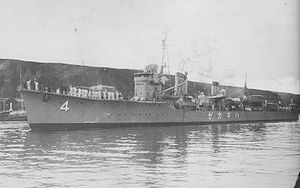Japanese destroyer Hagikaze
 Hagikaze on March 31, 1941.
| |
| History | |
|---|---|
| Name | Hagikaze |
| Builder | Uraga Dock Company |
| Launched | 18 June 1940 |
| Stricken | 15 October 1943 |
| Fate | Sunk in action, 7 August 1943 |
| General characteristics | |
| Class and type | Kagerō-class destroyer |
| Displacement | 2,490 long tons (2,530 t) |
| Length | 118.5 m (388 ft 9 in) |
| Beam | 10.8 m (35 ft 5 in) |
| Draft | 3.8 m (12 ft 6 in) |
| Speed | 35 knots (40 mph; 65 km/h) |
| Complement | 240 |
| Armament |
|
| Service record | |
| Operations: | Battle of Vella Gulf (1943) |
Hagikaze (萩風, Clover Wind) was one of 19 Kagerō-class destroyers built for the Imperial Japanese Navy during the 1930s.
Design and description
[edit]The Kagerō class was an enlarged and improved version of the preceding Asashio class. Their crew numbered 240 officers and enlisted men. The ships measured 118.5 meters (388 ft 9 in) overall, with a beam of 10.8 meters (35 ft 5 in) and a draft of 3.76 meters (12 ft 4 in).[1] They displaced 2,065 metric tons (2,032 long tons) at standard load and 2,529 metric tons (2,489 long tons) at deep load.[2] The ships had two Kampon geared steam turbines, each driving one propeller shaft, using steam provided by three Kampon water-tube boilers. The turbines were rated at a total of 52,000 shaft horsepower (39,000 kW) for a designed speed of 35 knots (65 km/h; 40 mph). The ships had a range of 5,000 nautical miles (9,300 km; 5,800 mi) at a speed of 18 knots (33 km/h; 21 mph).[3]
The main armament of the Kagerō class consisted of six Type 3 127-millimeter (5.0 in) guns in three twin-gun turrets, one superfiring pair aft and one turret forward of the superstructure. They were built with four Type 96 25-millimeter (1.0 in) anti-aircraft guns in two twin-gun mounts, but more of these guns were added over the course of the war. The ships were also armed with eight 610-millimeter (24.0 in) torpedo tubes for the oxygen-fueled Type 93 "Long Lance" torpedo in two quadruple traversing mounts; one reload was carried for each tube.[2] Their anti-submarine weapons comprised 16 depth charges.[3]
Construction and career
[edit]Participating in the Battle of Midway, the heavily damaged aircraft carrier Kaga was scuttled by Hagikaze's two torpedoes, Kaga being fatally damaged by US aircraft from USS Enterprise during the battle.
On 7 August 1943, Hagikaze was sunk between Kolombangara and Vella Lavella (07°50′S 156°55′E / 7.833°S 156.917°E) during the Battle of Vella Gulf, by torpedoes and gunfire from the US destroyers USS Dunlap, USS Craven, and USS Maury, with 178 killed.
Notes
[edit]References
[edit]- Chesneau, Roger, ed. (1980). Conway's All the World's Fighting Ships 1922–1946. Greenwich, UK: Conway Maritime Press. ISBN 0-85177-146-7.
- Jentschura, Hansgeorg; Jung, Dieter & Mickel, Peter (1977). Warships of the Imperial Japanese Navy, 1869–1945. Annapolis, Maryland: United States Naval Institute. ISBN 0-87021-893-X.
- Whitley, M. J. (1988). Destroyers of World War 2. Annapolis, Maryland: Naval Institute Press. ISBN 0-87021-326-1.
